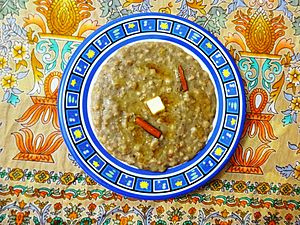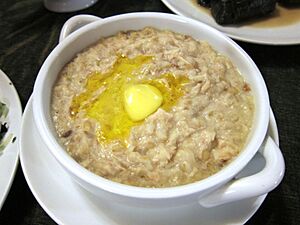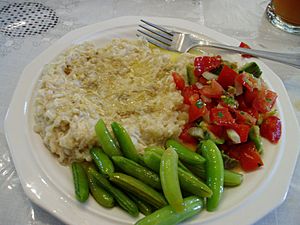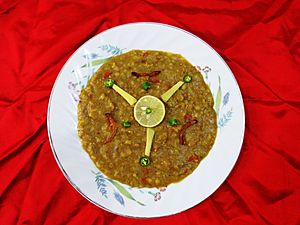Harees facts for kids
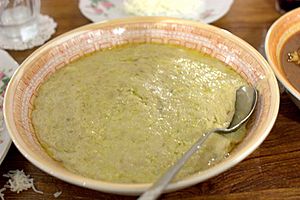 |
|
| Alternative names | Jareesh, Hareesa, Haleem, Arizah |
|---|---|
| Type | Porridge |
| Place of origin | Middle East United Arab Emirates |
| Region or state | Middle East And Horn of Africa |
| Main ingredients | Wheat, butter, and meat (usually mutton), sometimes Chicken |
Harees (also called jareesh, boko boko, or harisa) is a yummy dish made from wheat and meat. The wheat is usually cracked or coarsely ground. It's cooked until it becomes thick, like a porridge or a gruel.
Harees is very popular in the Arab world. People often eat it in countries around the Persian Gulf during the holy month of Ramadan. In Iraq and Lebanon, Shia Muslims sometimes eat it during Ashura.
Contents
What's in a Name? The Story of Harees
The word "Harees" (Arabic: هريس) comes from an Arabic word meaning "to mash" or "to squash." This makes sense because the dish is mashed until it's smooth.
There's a special story about "harissa" (another name for Harees) from Armenia. The patron saint of Armenia, Gregory the Illuminator, was once serving a meal to people in need. There wasn't enough meat for everyone. So, wheat was added to the cooking pots.
The wheat started sticking to the bottom of the pots. Saint Gregory told everyone, "Harekh!" which means "Stir it!" From his words, the dish got its name, harissa. Since then, harissa has been a meal shared as an act of kindness. It's often eaten on Easter and is even considered the national dish of Armenia.
A Look Back: The History of Harees
Harees is a very old dish! It's mentioned in cookbooks from a long time ago. One of the earliest mentions is in a 10th-century cookbook called Kitab Al Tabikh by Ibn Sayyar al-Warraq.
It also appears in other old cookbooks from the 13th century. These books show that Harees has been enjoyed for hundreds of years. Harees is also the original dish that another popular food, haleem, came from.
How to Make Harees
Making Harees takes a bit of time and care. First, the wheat is soaked in water overnight. This makes it softer and easier to cook.
Then, the soaked wheat is simmered (cooked slowly) in water with meat. Butter or sheep fat is also added for flavor. Once it's cooked, any extra liquid is removed. The mixture is then beaten until it's smooth and thick. Finally, it's seasoned with spices. Sometimes, people add cinnamon, sugar, or clarified butter on top for extra taste.
Different Ways to Enjoy Harees
Harees is made in slightly different ways across the Arabian Peninsula. Each country and even different tribes have their own special touches. These differences are usually small, like adding an extra spice.
For example, in Saudi Arabia, people sometimes add cardamom pods. They might also decorate the dish with fresh parsley.
Long ago, Harees was a special dish mostly made by wealthy families. They would prepare it during Ramadan and Eid ul-Fitr (a big holiday). It was also served at weddings that lasted several days. Even then, it was common for families to share their Harees with their neighbors who were less fortunate.
Harees is similar to a dish called kashkeg. Kashkeg is a thick porridge made from cooked and boned chicken or lamb and coarsely ground wheat.
Harees in Arab Countries
Harees is a very popular dish in Arab cuisine, from the Levant to the Persian Gulf. It's often served during special times like Ramadan and other festivals. It's also a favorite at weddings.
In Lebanon, Harees is sometimes cooked in a big pot for everyone to share on religious days, like Ashura. It's also a common and loved dish in Syrian cuisine and Iraqi cuisine. While it used to be a home-cooked meal, you can now find Harees in many restaurants too.
Armenian Harisa
Harisa (Armenian: հարիսա, romanized: harisa) is a very important dish in Armenia. It's traditionally served on Easter and is considered the national dish of the country. Harisa is a thick porridge made from korkot (which is dried or roasted cracked wheat) and rich meat, usually chicken or lamb.
On religious fasting days, people would use herbs instead of meat in their harissa. The cooking process for harissa takes a very long time. This long cooking time is part of what makes the dish so special and valued.
Harisa is also known for helping the Armenian people of Musa Dagh (a place in modern-day Turkey) survive a difficult time in 1915.
Hareesa in Kashmir
In Kashmir, Hareesa (ۂرؠ سہٕ) is a special dish made during the winter. It's especially popular during a very cold period called Chillai Kalan. This version is usually made with mutton and rice flour. People eat it with a type of Kashmiri bread called Girda.
Hareesa is cooked in huge clay pots called "degs" in wood-fired ovens. The area of Downtown Srinagar is famous for its Hareesa makers.
Boko Boko in Zanzibar
In Zanzibar, this dish is known as boko boko. It can be made with different kinds of meat, such as lamb, beef, or chicken.
Hareesa in Ethiopia
Hareesa or Harees is also a popular dish in Ethiopia, especially in the Oromo region. It's cooked with lamb or beef and often topped with a special clarified butter called dhadhaa or kibbeh. People usually serve it on Eid or for important family events, like when a baby is born.
See also
 In Spanish: Harís para niños
In Spanish: Harís para niños


